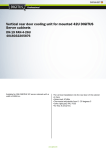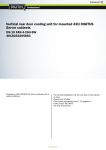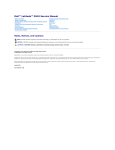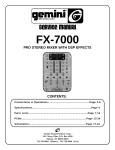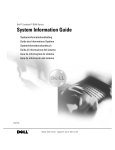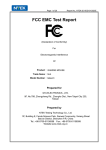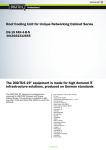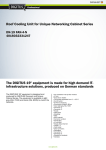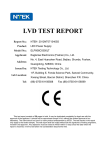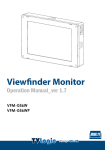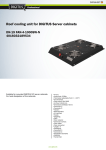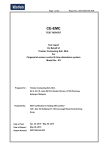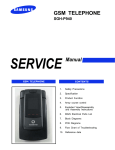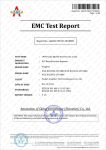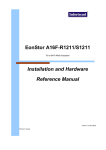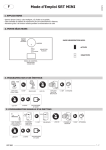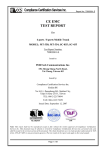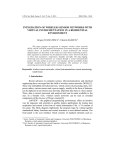Download WNP-RP-002 Radio test report
Transcript
RADIO TEST REPORT ETSI EN 300 328 V1.7.1 (2006-10) Product: Wireless AP Trade Name: N/A Model Name: WNP-RP-002 Serial Model: WT-U26, JWA-N2308 Report No.: NTEK-2013NT0905144R-01 Prepared for Gembird Europe B.V. Wittevrouwen 56, 1358 CD, Almere Haven, The Netherlands Prepared by Shenzhen NTEK Testing Technology Co., Ltd. 1/F, Building E, Fenda Science Park, Sanwei Community,Xixiang Street Bao’an District, Shenzhen P.R. China Tel.: +86-0755-61156588 Fax.: +86-0755-61156599 Website:www.ntek.org.cn Page 3 of 50 Report No.: NTEK-2013NT0905144R-01 Table of Contents 1 . SUMMARY OF TEST RESULTS Page 5 1.1 TEST FACILITY 6 1.2 MEASUREMENT UNCERTAINTY 6 2 . GENERAL INFORMATION 7 2.1 GENERAL DESCRIPTION OF EUT 7 2.2 TEST CONDITIONS AND CHANNEL 8 2.3 DESCRIPTION OF TEST CONDITIONS 9 2.4 DESCRIPTION OF SUPPORT UNITS 10 2.5 EQUIPMENTS LIST FOR ALL TEST ITEMS 11 3 . EFFECTIVE RADIATED POWER 3.1 APPLIED PROCEDURES / LIMIT 3.1.1 MEASURING INSTRUMENTS AND SETTING 3.1.2 TEST PROCEDURES 3.1.3 TEST SETUP LAYOUT 3.1.4 EUT Operation during Test 3.1.5 TEST RESULTS 4 . PEAK POWER DENSITY 4.1 APPLIED PROCEDURES / LIMIT 4.1.1 MEASURING INSTRUMENTS AND SETTING 4.1.2 TEST PROCEDURES 4.1.3 TEST SETUP LAYOUT 4.1.4 EUT OPERATION DURING TEST 4.1.5 TEST RESULTS 5 . FREQUENCY RANGE 5.1 APPLIED PROCEDURES / LIMIT 5.1.1 MEASURING INSTRUMENTS AND SETTING 5.1.2 TEST PROCEDURES 5.1.3 TEST SETUP LAYOUT 5.1.4 EUT OPERATION DURING TEST 5.1.5 TEST RESULTS 6 . SPURIOUS EMISSIONS – TRANSMITTER (30- 1000MHZ) 6.1 APPLIED PROCEDURES / LIMIT 6.1.1 MEASURING INSTRUMENTS AND SETTING 6.1.2 TEST PROCEDURES 6.1.3 TEST SETUP LAYOUT 6.1.4 EUT OPERATION DURING TEST 6.1.5 TEST RESULTS (30MHz ~ 1000MHz) 12 12 12 12 12 12 13 15 15 15 15 16 16 17 33 33 33 34 34 34 35 37 37 37 37 38 38 39 Page 4 of 50 Report No.: NTEK-2013NT0905144R-01 Table of Contents 7 . SPURIOUS EMISSIONS – TRANSMITTER (ABOVE 1000MHZ) Page 40 7.1 APPLIED PROCEDURES / LIMIT 7.1.1 MEASURING INSTRUMENTS AND SETTING 7.1.2 TEST PROCEDURES 7.1.3 TEST SETUP LAYOUT 7.1.4 EUT OPERATION DURING TEST 7.1.5 TEST RESULTS 40 40 41 41 42 43 8 . SPURIOUS EMISSIONS – RECEIVER (30-1000MHZ) 45 8.1 APPLIED PROCEDURES / LIMIT 8.1.1 MEASURING INSTRUMENTS AND SETTING 8.1.2 TEST PROCEDURES 8.1.3 TEST SETUP LAYOUT 8.1.4 EUT OPERATION DURING TEST 8.1.5 TEST RESULTS (30MHz-1000MHz) 45 45 45 45 45 46 9 . SPURIOUS EMISSIONS – RECEIVER (ABOVE 1000MHZ) 9.1 APPLIED PROCEDURES / LIMIT 9.1.1 MEASURING INSTRUMENTS AND SETTING 9.1.2 TEST PROCEDURES 9.1.3 TEST SETUP LAYOUT 9.1.4 EUT OPERATION DURING TEST 9.1.5 TEST RESULTS (ABOVE 1000MHZ) 10 .MEDIUM ACCESS PROTOCOL 10.1 APPLIED PROCEDURES / LIMIT 10.1.1 TEST RESULTS 11 . EUT TEST PHOTO APPENDIX-PHOTOGRAPHS OF EUT CONSTRUCTIONAL DETAILS 47 47 47 47 47 47 48 49 49 49 50 Page 5 of 50 Report No.: NTEK-2013NT0905144R-01 1. SUMMARY OF TEST RESULTS Test procedures according to the technical standards: ETSI EN 300 328 V1.7.1 Clause Test Item Limit Frequency Range (MHz) Applicable (Yes/No) 4.2.1 4.3.4 TRANSMITTER PARAMETERS Number of hopping >=15 channel Hopping channel carrier the 20dB bandwidth of the 2400-2483.5 frequency separated hopping channel Average time of < = 0.4 sec occupancy N 4.3.1 Effective radiated power 2400-2483.5 Y 2400-2483.5 N 2400-2483.5 Y 2400-2483.5 N 2400-2483.5 Y 4.3.2 4.3.3 4.3.6 4.3.6 Peak power density Frequency range Spurious emissions (conducted) Spurious emissions (radiated) AV: -10 dBW(20 dBm) FHSS N/A DSSS/OFDM, Other modulation 10 mW/MHz FHSS / e.i.r.p. -80dBm/Hz Other modulation / e.i.r.p. -80dBm/Hz Operating: -36dBm Standby: -57dBm Operating: -30dBm Standby: -47dBm Operating: -47dBm Standby: -47dBm Operating: -36dBm Standby: -57dBm Operating: -30dBm Standby: -47dBm Operating: -47dBm Standby: -47dBm -47dBm 4.3.5 30-1000 1000-12750 N 1800-1900 5150-5300 30-1000 1000-12750 1800-1900 5150-5300 Y 1000-12750 MEDIUM ACCESS PROTOCOL Y RECEIVER PARAMETERS 4.3.7 Spurious emissions (conducted) Spurious emissions (radiated) -57dBm 30-1000 -47dBm 1000-12750 -57dBm 30-1000 N Y Page 6 of 50 Report No.: NTEK-2013NT0905144R-01 1.1 TEST FACILITY NTEK Testing Technology Co., Ltd. Add. : 1/F, Building E, Fenda Science Park, Sanwei Community, Xixiang Street, Bao'an District, Shenzhen P.R. China FCC Registered No.: 238937 IC Registered No.:9270A-1 CNAS Registration No.:L5516 1.2 MEASUREMENT UNCERTAINTY The reported uncertainty of measurement y ± U,where expended uncertainty U is based on a standard uncertainty multiplied by a coverage factor of k=2,providing a level of confidence of approximately 95 %。 No. Item Uncertainty 1 Conducted Emission Test ±1.38dB 2 RF power,conducted ±0.16dB 3 Spurious emissions,conducted ±0.21dB 4 All emissions,radiated(<1G) ±4.68dB 5 All emissions,radiated(>1G) ±4.89dB 6 Temperature ±0.5°C 7 Humidity ±2% Page 7 of 50 Report No.: NTEK-2013NT0905144R-01 2. GENERAL INFORMATION 2.1 GENERAL DESCRIPTION OF EUT Equipment Wireless AP Brand Name N/A Model Name. WNP-RP-002 Serial Model WT-U26, JWA-N2308 All the model are the same circuit and RF module,except the mode names. The EUT is Wireless AP Operation 802.11b/g/n(20MHz): 2412~2472MHz Frequency: 802.11n(40MHz):2422~2462MHz Modulation Type: CCK/OFDM/DBPSK/DAPSK Bit Rate of 802.11b:11/5.5/2/1 Mbps Transmitter 802.11g:54/48/36/24/18/12/9/6Mbps Model Difference 802.11n(20MHz):150/144.44/130/1 17/115.56/104/86.67/78/52/6.5Mbps 802.11n(40MHz):300/270/240/18 0/150/120/108/90/54 Mbps Product Description Number Of Channel Antenna Designation: Antenna Gain(Peak) EIRP Power: 13CH .Please see Note 2. FPCB Antenna 1.0dBi 802.11b: 15.67 dBm (Max.) 802.11g: 14.83 dBm (Max.) 802.11n(20M) : 13.87 dBm (Max.) 802.11n (40M): 11.65 dBm (Max.) Based on the application, features, or specification exhibited in User's Manual, the EUT is considered as an ITE/Computing Device. More details of EUT technical specification, please refer to the User's Manual. Channel List Refer to below Adapter N/A Battery N/A Hardware Version N/A Software Version N/A Page 8 of 50 Report No.: NTEK-2013NT0905144R-01 Note: 1. For a more detailed features description, please refer to the manufacturer’s specifications or the User's Manual. 2. Channel List Channel Frequency (MHz) Channel Frequency (MHz) Channel Frequency (MHz) 01 02 03 04 2412 2417 2422 2427 05 06 07 08 2432 2437 2442 2447 09 10 11 12 2452 2457 2462 2467 Channel Frequency (MHz) 13 2472 2.2 TEST CONDITIONS AND CHANNEL Temperature Relative Humidity Supply Voltage Normal Test Conditions 15°C - 35°C 20% - 75% DC 3.7V Extreme Test Conditions -20°C ~ 55°C Note: (1) N/A DC 3.5V – DC 4.2V Note: (2) 11B/11G/11N(20M) Test Channel lowest middle highest EUT Channel CH01 CH07 CH13 Test Frequency (MHz) 2412 2442 2472 11G/11N(40M) Test Channel lowest middle highest EUT Channel CH03 CH07 CH11 Test Frequency (MHz) 2422 2442 2462 Note: (1) The HT 55°C and LT -20°C was declarated by manufacturer, The EUT couldn’t be operate normally with higher or lower temperature. (2) The High Voltage 4.2V and Low Voltage 3.5V was declarated by manufacturer, The EUT couldn’t be operate normally with higher or lower voltage. (3) The measurements are performed at the highest, middle, lowest available channels. Page 9 of 50 Report No.: NTEK-2013NT0905144R-01 2.3 DESCRIPTION OF TEST CONDITIONS E-2 Notebook AC Plug C-2 E-1 EUT Page 10 of 50 Report No.: NTEK-2013NT0905144R-01 2.4 DESCRIPTION OF SUPPORT UNITS The EUT has been tested as an independent unit together with other necessary accessories or support units. The following support units or accessories were used to form a representative test configuration during the tests. Item Equipment Brand Model/Type No. Series No. Note E-1 Wireless AP N/A WNP-RP-002 N/A EUT E-2 Notebook DELL PP10L N/A Ferrite Core Length NO 80cm Item Shielded Type C-1 NO Note Note: (1) (2) The support equipment was authorized by Declaration of Confirmation. For detachable type I/O cable should be specified the length in cm in『Length』column. Page 11 of 50 Report No.: NTEK-2013NT0905144R-01 2.5 EQUIPMENTS LIST FOR ALL TEST ITEMS Item 1 2 3 4 5 6 7 8 9 10 11 12 13 Kind of Manufactur Type No. Equipment er Spectrum Agilent E4407B Analyzer Test R&S ESPI Receiver Bilog TESEQ CBL6111D Antenna 50Ω Coaxial Anritsu MP59B Switch Spectrum ADVANTES R3132 Analyzer T Horn EM-AH-20 EM Antenna 180 Schwarzbec BBHA Horn Ant k 9170 Amplifier EM EM-30180 Loop PLA-2030/ ARA Antenna B Power R&S NRVS Meter Signal R&S SMT 06 Generator Temperatur e& GIANT GTH-056P FORCE Humitidy Chamber Power R&S URV5-Z4 Sensor (AV) Serial No. Last calibration Calibrated until Calibration period 160400005 2013.07.06 2014.07.05 1 year 101318 2013.07.06 2014.07.05 1 year 31216 2013.07.06 2014.07.05 1 year 6200264416 2013.07.06 2014.07.05 1 year 150900201 2013.07.06 2014.07.05 1 year 2011071402 2013.07.06 2014.07.05 1 year 9170-181 2013.07.06 2014.07.05 1 year 060538 2013.07.06 2014.07.05 1 year 1029 2013.07.06 2014.07.05 1 year 100696 2013.07.06 2014.07.05 1 year 832080/007 2013.07.06 2014.07.05 1 year GF-94454-1 2013.07.06 2014.07.05 1 year 0395.1619.05 2013.07.06 2014.07.05 1 year Page 12 of 50 Report No.: NTEK-2013NT0905144R-01 3. EFFECTIVE RADIATED POWER 3.1 APPLIED PROCEDURES / LIMIT Clause Test Item 4.3.1 Effective radiated power Limit AV: -10 dBW (20 dBm) 3.1.1 MEASURING INSTRUMENTS AND SETTING Please refer to section 4.1.1 in this report. The following table is the setting of the power meter. Power Meter Parameter Setting Filter No. Auto Measurement time 0.135 s ~ 26 s Used Average Sensor URV5-Z4 3.1.2 TEST PROCEDURES a. Since a temporary antenna connector can be attached on the RF output port, so conducted measurement method was used in this case. b. A wide band power meter with a matched thermocouple detector was used to directly measure the output power from the RF output port of the EUT in continuously transmitting mode. c. The EIRP = A+G+10*log(1/x), where A is the power measured in (1), G is the gain of the antenna of the EUT in dBi and x is the duty cycle of the EUT in continuously transmitting mode. d. The measurement shall be repeated at the lowest, the Wireless AP dle, and the highest channel of the stated frequency range. These measurements shall also be performed at normal and extreme test conditions. 3.1.3 TEST SETUP LAYOUT 3.1.4 EUT Operation during Test The EUT was programmed to be in continuously transmitting mode. Page 13 of 50 Report No.: NTEK-2013NT0905144R-01 3.1.5 TEST RESULTS EUT: Temperature: Pressure: Test Mode : Model Name : Wireless AP WNP-RP-002 26°C Relative Humidity: 60 % Test Voltage : 1012 hPa DC3.7V(NORMAL) TX 11B Mode CH1 / CH7 / CH13 Average EIRP Power ( dBm ) CH1 CH7 CH13 TEST CONDITIONS T nom (°C) 20 T min (°C) -20 T max (°C) 55 EUT: Temperature: Pressure: Test Mode : V nom (V) 3.7 15.67 15.63 15.24 V max (V) 4.2 15.58 15.12 15.37 V min (V) 3.5 15.44 15.45 15.31 V max (V) 4.2 15.38 15.49 15.46 V min (V) 3.5 15.41 15.50 15.25 Max Peak Power 15.67dBm Limits 20dBm (-10dBW) Result Complies Model Name : Wireless AP WNP-RP-002 26°C Relative Humidity: 60 % Test Voltage : 1012 hPa DC3.7V(NORMAL) TX 11G Mode CH1 / CH7 / CH13 Average EIRP Power ( dBm ) CH1 CH7 CH13 TEST CONDITIONS T nom (°C) 20 T min (°C) -20 T max (°C) 55 V nom (V) 3.7 14.53 14.66 14.75 V max (V) 4.2 14.76 14.83 14.53 V min (V) 3.5 14.65 14.76 14.55 V max (V) 4.2 14.37 14.57 11.55 V min (V) 3.5 14.64 14.86 14.57 Max Peak Power 14.83 dBm Limits 20dBm (-10dBW) Result Complies Page 14 of 50 EUT: Temperature: Pressure: Test Mode : Model Name : Wireless AP WNP-RP-002 26°C Relative Humidity: 60 % Test Voltage : 1012 hPa DC3.7V(NORMAL) TX 11N Mode CH1 / CH7 / CH13/20MHz Average EIRP Power ( dBm ) CH1 CH7 CH13 TEST CONDITIONS T nom (°C) 20 T min (°C) -20 T max (°C) 55 EUT: Temperature: Pressure: Test Mode : Report No.: NTEK-2013NT0905144R-01 V nom (V) 3.7 13.87 13.58 13.74 V max (V) 4.2 13.69 13.71 13.66 V min (V) 3.5 13.75 13.68 13.42 V max (V) 4.2 13.64 13.70 13.62 V min (V) 3.5 13.72 13.54 13.55 Max Peak Power 13.87 dBm Limits 20dBm (-10dBW) Result Complies Model Name : Wireless AP WNP-RP-002 26°C Relative Humidity: 60 % Test Voltage : 1012 hPa DC3.7V(NORMAL) TX 11N Mode CH3 / CH7 / CH11/40MHz Average EIRP Power ( dBm ) CH3 CH7 CH11 TEST CONDITIONS T nom (°C) 20 T min (°C) -20 T max (°C) 55 V nom (V) 3.7 11.63 11.22 11.65 V max (V) 4.2 11.45 11.37 11.25 V min (V) 3.5 11.38 11.40 11.36 V max (V) 4.2 11.59 11.36 11.41 V min (V) 3.5 11.43 11.53 11.32 Max Peak Power 11.65 dBm Limits 20dBm (-10dBW) Result Complies Page 15 of 50 Report No.: NTEK-2013NT0905144R-01 4. PEAK POWER DENSITY 4.1 APPLIED PROCEDURES / LIMIT Clause Test Item 4.3.2 Peak power density Limit FHSS N/A DSSS/OFDM, Other modulation 10 mW/MHz 4.1.1 MEASURING INSTRUMENTS AND SETTING Please refer to section 5.1.1 in this report. The following table is the setting of the power meter. Power Meter Parameter Setting Filter No. Auto Measurement time 0.135 s ~ 26 s Used Average Sensor URV5-Z4 4.1.2 TEST PROCEDURES Step 1: Connect the UUT to the spectrum analyser and use the following settings: • Centre Frequency: The centre frequency of the channel under test. • Resolution BW: 1 MHz. • Video BW: 1 MHz. • Span: Wide enough to cover the complete power envelope of the signal of the UUT. • Detector: Peak. • Trace Mode: Max Hold. Step 2: When the trace is complete, find the peak value of the power envelope and record the frequency. Step 3: Make the following changes to the settings of the spectrum analyser: • Centre Frequency: Equal to the frequency recorded in step 2. • Span: 3 MHz. • Resolution BW: 1 MHz. • Video BW: 1 MHz. • Sweep time: 1 minute. • Detector: Average (see note). • Trace Mode: Max Hold. Note: The detector mode "Average" is often referred to as "RMS Average" or "Sample" but do not use Video Average. Page 16 of 50 Report No.: NTEK-2013NT0905144R-01 Step 4: When the trace is complete, capture the trace, for example using the "View" option on the spectrum analyser. Find the peak value of the trace and place the analyser marker on this peak. This level is recorded as the highest mean power (spectral power density) D in a 1 MHz band. Alternatively, where a spectrum analyser is equipped with a facility to measure spectral power density, this facility may be used to display the spectral power density D in dBm/MHz. Step 5: The maximum e.i.r.p. spectral density is calculated from the above measured power density (D), the observed duty cycle x (see clause 5.7.2.2, step 1), and the applicable antenna assembly gain "G" in dBi, according to the formula below. If more than one antenna assembly is intended for this power setting, the gain of the antenna assembly with the highest gain shall be used. • PD = D + G + 10 log (1/x); • PD shall be recorded in the test report. 4.1.3 TEST SETUP LAYOUT ` 4.1.4 EUT OPERATION DURING TEST The EUT was programmed to be in continuously transmitting mode. Page 17 of 50 Report No.: NTEK-2013NT0905144R-01 4.1.5 TEST RESULTS EUT: Temperature: Pressure: Test Mode : Model Name : Wireless AP WNP-RP-002 26°C Relative Humidity: 60 % Test Voltage : 1012 hPa DC3.7V(NORMAL) TX 11B Mode CH1 /CH7/ CH13 Reading Antenna Frequency Power Density Limit (dBm/MHz) (dBm/MHz) 10 log(1/x) (dBm/MHz) Gain (dBi) 2412 -1.339 0 -0.339 10 2442 -1.206 1.0 1.0 0 -0.209 10 2472 -1.825 1.0 0 -0.825 10 10 log (1/x) = 0, X=duty cycle=Ton/Tp, Ton= 100 ms, Tp= 100 ms Low Channel Page 18 of 50 Middle Channel Report No.: NTEK-2013NT0905144R-01 Page 19 of 50 High Channel Report No.: NTEK-2013NT0905144R-01 Page 20 of 50 Report No.: NTEK-2013NT0905144R-01 Page 21 of 50 EUT: Temperature: Pressure: Test Mode : Report No.: NTEK-2013NT0905144R-01 Model Name : Wireless AP WNP-RP-002 26°C Relative Humidity: 60 % Test Voltage : 1012 hPa DC3.7V(NORMAL) TX 11G Mode CH1 /CH7/ CH13 Reading Antenna Frequency Power Density Limit (dBm/MHz) (dBm/MHz) 10 log(1/x) (dBm/MHz) Gain (dBi) 2412 -5.707 1.0 0 -4.707 10 2442 -4.522 1.0 0 -3.522 10 2472 -3.516 1.0 0 -2.516 10 10 log (1/x) = 0, X=duty cycle=Ton/Tp, Ton= 100 ms, Tp= 100 ms Low Channel Page 22 of 50 Middle Channel Report No.: NTEK-2013NT0905144R-01 Page 23 of 50 High Channel Report No.: NTEK-2013NT0905144R-01 Page 24 of 50 Report No.: NTEK-2013NT0905144R-01 Page 25 of 50 EUT: Temperature: Pressure: Test Mode : Report No.: NTEK-2013NT0905144R-01 Model Name : Wireless AP WNP-RP-002 26°C Relative Humidity: 60 % Test Voltage : 1012 hPa DC3.7V(NORMAL) TX 11N Mode CH1 /CH7/ CH13/20MHz Reading Antenna Frequency Power Density Limit (dBm/MHz) (dBm/MHz) 10 log(1/x) (dBm/MHz) Gain (dBi) 2412 -7.168 1.0 0 -6.168 10 2442 -7.222 1.0 0 -6.222 10 2472 -6.731 1.0 0 -5.731 10 10 log (1/x) = 0, X=duty cycle=Ton/Tp, Ton= 100 ms, Tp= 100 ms Low Channel Page 26 of 50 Middle Channel Report No.: NTEK-2013NT0905144R-01 Page 27 of 50 High Channel Report No.: NTEK-2013NT0905144R-01 Page 28 of 50 Report No.: NTEK-2013NT0905144R-01 Page 29 of 50 EUT: Temperature: Pressure: Test Mode : Report No.: NTEK-2013NT0905144R-01 Model Name : Wireless AP WNP-RP-002 26°C Relative Humidity: 60 % Test Voltage : 1012 hPa DC3.7V(NORMAL) TX 11N Mode CH3 /CH7/ CH11/40MHz Reading Antenna Frequency Power Density Limit (dBm/MHz) (dBm/MHz) 10 log(1/x) (dBm/MHz) Gain (dBi) 2422 -10.18 1.0 0 -9.18 10 2442 -10.69 1.0 0 -9.69 10 2462 -11.36 1.0 0 -10.36 10 10 log (1/x) = 0, X=duty cycle=Ton/Tp, Ton= 100 ms, Tp= 100 ms Low Channel Page 30 of 50 Middle Channel Report No.: NTEK-2013NT0905144R-01 Page 31 of 50 High Channel Report No.: NTEK-2013NT0905144R-01 Page 32 of 50 Report No.: NTEK-2013NT0905144R-01 Page 33 of 50 Report No.: NTEK-2013NT0905144R-01 5. FREQUENCY RANGE 5.1 APPLIED PROCEDURES / LIMIT Clause Test Item 4.3.3 Frequency range Limit -80dBm/Hz The frequency range of the equipment is determined by the lowest and highest frequencies occupied by the power envelope. fH is the highest frequency of the power envelope: it is the frequency furthest above the frequency of maximum power where the output power drops below the level of -80 dBm/Hz e.i.r.p. spectral power density (-30 dBm if measured in a 100 kHz bandwidth). fL is the lowest frequency of the power envelope; it is the frequency furthest below the frequency of maximum power where the output power drops below the level equivalent to -80 dBm/Hz e.i.r.p. spectral power density (or -30 dBm if measured in a 100 kHz bandwidth). The frequency range is determined by the lowest value of fL and the highest value of fH resulting from the adjustment of the equipment to the lowest and highest operating frequencies. For all equipment, the frequency range shall lie within the band 2.4 GHz to 2,4835 GHz (fL > 2.4 GHz and fH < 2.4835 GHz). 5.1.1 MEASURING INSTRUMENTS AND SETTING Please refer to section 6.1.1 in this report. The following table is the setting of Spectrum Analyzer. Spectrum Analyzer Setting Attenuation 20~30dB Span Frequency 40MHz RB 100 kHz VB 100 kHz Detector Average Sweep time ≥ 60s Trace Average 50 sweeps Page 34 of 50 Report No.: NTEK-2013NT0905144R-01 5.1.2 TEST PROCEDURES a. The transmitter output (antenna port) was connected to the spectrum analyzer. b. Added [x] dBi of antenna gain was on the spectrum analyzer. c. Place the spectrum analyzer in detector averaging mode with a minimum of 50 sweeps selected and activate transmitter with modulation applied. d. Select lowest operating frequency of the equipment under test. e. Find lowest frequency below the operating frequency at which spectral power density drops below -80 dBm/Hz e.i.r.p. (-30 dBm if measured in a 100 kHz bandwidth). This frequency shall be recorded (fL). f. Select the highest operating frequency of the equipment under test. g. Find the highest frequency at which the spectral power density drops below-80 dBm/Hz e.i.r.p. (-30 dBm if measured in a 100 kHz bandwidth). This frequency shall be recorded (fH). h. These measurements shall also be performed at normal and extreme test conditions. 5.1.3 TEST SETUP LAYOUT 5.1.4 EUT OPERATION DURING TEST The EUT was programmed to be in continuously transmitting mode. Page 35 of 50 Report No.: NTEK-2013NT0905144R-01 5.1.5 TEST RESULTS EUT: Temperature: Pressure: Test Mode : Model Name : WNP-RP-002 Relative Humidity: 60 % Test Voltage : DC3.7V(NORMAL) Wireless AP 26 °C 1012 hPa TX 11B Mode CH1 / CH13 Frequency range ( MHz ) TEST CONDITIONS T nom (°C) 20.00 T min (°C) -20.00 T max (°C) 55.00 fL CH1 fH CH13 V nom (V) 3.7 2401.4125 2482.4352 V max (V) 4.2 2401.4348 2482.6524 V min (V) 3.5 2401.3546 2482.5457 V max (V) 4.2 2401.4278 2482.5654 V min (V) 3.5 2401.2255 2482.5656 Min. fL / Max. fH Band Edges 2401.3217 2482.4454 EU / Australia / NZ Limits fL > 2400.0 MHz fH < 2483.5 MHz Result EUT: Temperature: Pressure: Test Mode : Complies Model Name : WNP-RP-002 Relative Humidity: 60 % Test Voltage : DC3.7V(NORMAL) Wireless AP 26 °C 1012 hPa TX 11G Mode CH1 / CH13 Frequency range ( MHz ) TEST CONDITIONS T nom (°C) 20.00 T min (°C) -20.00 T max (°C) 55.00 fL CH1 fH CH13 V nom (V) 3.7 2401.4341 2482.5634 V max (V) 4.2 2401.3458 2482.5441 V min (V) 3.5 2401.4554 2482.5627 V max (V) 4.2 2401.5642 2482.5642 V min (V) 3.5 2401.6542 2482.5678 Min. fL / Max. fH Band Edges 2401.3464 2482.2865 Other EU / Australia / NZ Limits fL > 2400.0 MHz fH < 2483.5 MHz Result Complies Page 36 of 50 EUT: Temperature: Pressure: Test Mode : Model Name : WNP-RP-002 Relative Humidity: 60 % Test Voltage : DC3.7V(NORMAL) Wireless AP 26 °C 1012 hPa TX 11N Mode CH1 / CH13 Frequency range ( MHz ) TEST CONDITIONS T nom (°C) 20.00 T min (°C) -20.00 T max (°C) 55.00 Report No.: NTEK-2013NT0905144R-01 fL CH1 fH CH13 V nom (V) 3.7 2401.5652 2482.5348 V max (V) 4.2 2401.5221 2482.5640 V min (V) 3.5 2401.5414 2482.5147 V max (V) 4.2 2401.4537 2482.5669 V min (V) 3.5 2401.4514 2482.5147 Min. fL / Max. fH Band Edges 2401.3456 2482.1832 Other EU / Australia / NZ Limits fL > 2400.0 MHz fH < 2483.5 MHz Result EUT: Temperature: Pressure: Test Mode : Complies Model Name : Wireless AP WNP-RP-002 26 °C Relative Humidity: 60 % Test Voltage : 1012 hPa DC3.7V(NORMAL) TX 11N Mode CH3 / CH11/40MHz Frequency range ( MHz ) TEST CONDITIONS T nom (°C) 20.00 T min (°C) -20.00 T max (°C) 55.00 fL CH3 fH CH11 V nom (V) 3.7 2401.4575 2482.4211 V max (V) 4.2 2401.5382 2482.5742 V min (V) 3.5 2401.5422 2482.5395 V max (V) 4.2 2401.5487 2482.5478 V min (V) 3.5 2401.6345 2482.4289 Min. fL / Max. fH Band Edges 2401.4521 2482.6692 Other EU / Australia / NZ Limits fL > 2400.0 MHz fH < 2483.5 MHz Result Complies Page 37 of 50 Report No.: NTEK-2013NT0905144R-01 6. SPURIOUS EMISSIONS – TRANSMITTER (30- 1000MHZ) 6.1 APPLIED PROCEDURES / LIMIT Clause Test Item Spurious emissions 4.3.6 Frequency(MHz) 30-1000 1000-12750 (radiated) 1800-1900 5150-5300 Limit Operating Standby Operating Standby Operating Standby -36dBm -57dBm -30dBm -47dBm -47dBm -47dBm 6.1.1 MEASURING INSTRUMENTS AND SETTING Please refer to section 7.1.1 in this report. The following table is the setting of the Spectrum Analyzer. Spectrum Analyzer Setting Attenuation Auto Start Frequency 30 MHz Stop Frequency 1000 MHz Detector Positive Peak Span 100 MHz Sweep Time 1s RB / VB 100 kHz / 30 kHz 6.1.2 TEST PROCEDURES a. The EUT was placed on the top of the turntable in open test site area. b. The test shall be made in the transmitting mode. The turntable was rotated by 360 degrees to determine the position of the highest radiation. c. This measurement shall be repeated with the transmitter in standby mode where applicable. d. For 30~1000MHz spurious emissions measurement, the broad band bi-log receiving antenna was placed 3 meters far away from the turntable. e. The broadband receiving antenna was fixed on the same height with the EUT to find each suspected emissions of both horizontal and vertical polarization. Each recorded suspected value is indicated as Read Level (Raw). f. Replace the EUT by standard antenna and feed the RF port by signal generator. g. Adjust the frequency of the signal generator to the suspected emission and slightly rotate the turntable to locate the position with maximum reading. h. Adjust the power level of the signal generator to reach the same reading with Read Level (Raw). i. The level of the spurious emission is the power level of (8) plus the gain of the standard antenna in dBi and minus the loss of the cable used between the signal generator and the standard antenna. j. If the level calculated in (9) is higher than limit by more than 6dB, then lower the RBW of the spectrum analyzer to 30KHz. If the level of this emission does not change by more than 2dB, then it is taken as narrowband emission, otherwise, wideband emission. k. The measurement shall be repeated at the lowest and the highest channel of the stated frequency range. H. EUT Orthogonal Axis: “X” - denotes Laid on Table; ”Y” - denotes Vertical Stand; ”Z” - denotes Side Stand. Page 38 of 50 Report No.: NTEK-2013NT0905144R-01 6.1.3 TEST SETUP LAYOUT (A) Radiated Emission Test Set-Up Frequency Below 1 GHz 6.1.4 EUT OPERATION DURING TEST The EUT was programmed to be in continuously transmitting mode. For the initial investigation on the highest, middle, lowest frequency in 30-1000MHz, no significant differences in spurious emissions were observed between these 3 modes. The worst test data was shown Page 39 of 50 Report No.: NTEK-2013NT0905144R-01 6.1.5 TEST RESULTS (30MHz ~ 1000MHz) EUT: Temperature: Pressure: Test Mode : Model Name : WNP-RP-002 Relative Humidity: 54% Test Power : DC3.7V Wireless AP 24 ℃ 1010 hPa TX Polar (H/V) Frequency Meter Reading Factor Emission Level Limits Margin (MHz) (dBm) (dB) (dBm) (dBm) (dB) V V V H H H 68.6310 207.8497 554.8251 45.6948 135.0319 595.1326 -74.06 -77.64 -90.03 -78.95 -79.49 -87.62 5.76 9.14 22.43 10.25 11.99 20.92 -68.3 -68.5 -67.6 -68.7 -67.5 -66.7 -57 -57 -57 -57 -57 -57 -11.3 -11.5 -10.6 -11.7 -10.5 -9.7 Remark: Absolute Level= ReadingLevel+ Factor, Margin= Absolute Level - Limit Detector Type peak peak peak peak peak peak Page 40 of 50 Report No.: NTEK-2013NT0905144R-01 7. SPURIOUS EMISSIONS – TRANSMITTER (ABOVE 1000MHZ) 7.1 APPLIED PROCEDURES / LIMIT Clause Test Item Spurious emissions 4.3.6 Frequency(MHz) 30-1000 1000-12750 (narrowband) 1800-1900 5150-5300 Limit Operating Standby Operating Standby Operating Standby -36dBm -57dBm -30dBm -47dBm -47dBm -47dBm 7.1.1 MEASURING INSTRUMENTS AND SETTING Please refer to section 7.1.1 in this report. The following table is the setting of the Spectrum Analyzer. Spectrum Analyzer Setting Attenuation Auto Start Frequency 1000 MHz Stop Frequency 12750 MHz Detector Positive Peak Span 100 MHz Sweep Time 1s RB / VB 100 kHz / 30 kHz Page 41 of 50 Report No.: NTEK-2013NT0905144R-01 7.1.2 TEST PROCEDURES a. The EUT was placed on the top of the turntable in open test site area. b. The test shall be made in the transmitting mode. The turntable was rotated by 360 degrees to determine the position of the highest radiation. c. This measurement shall be repeated with the transmitter in standby mode where applicable. d. For 30~1000MHz spurious emissions measurement, the broad band bi-log receiving antenna was placed 3 meters far away from the turntable. e. The broadband receiving antenna was fixed on the same height with the EUT to find each suspected emissions of both horizontal and vertical polarization. Each recorded suspected value is indicated as Read Level (Raw). f. Replace the EUT by standard antenna and feed the RF port by signal generator. g. Adjust the frequency of the signal generator to the suspected emission and slightly rotate the turntable to locate the position with maximum reading. h. Adjust the power level of the signal generator to reach the same reading with Read Level (Raw). i. The level of the spurious emission is the power level of (8) plus the gain of the standard antenna in dBi and minus the loss of the cable used between the signal generator and the standard antenna. j. If the level calculated in (9) is higher than limit by more than 6dB, then lower the RBW of the spectrum analyzer to 30KHz. If the level of this emission does not change by more than 2dB, then it is taken as narrowband emission, otherwise, wideband emission. k. The measurement shall be repeated at the lowest and the highest channel of the stated frequency range. H. EUT Orthogonal Axis: “X” - denotes Laid on Table; ”Y” - denotes Vertical Stand; ”Z” - denotes Side Stand. 7.1.3 TEST SETUP LAYOUT Page 42 of 50 Report No.: NTEK-2013NT0905144R-01 7.1.4 EUT OPERATION DURING TEST The EUT was programmed to be in continuously transmitting mode. Page 43 of 50 Report No.: NTEK-2013NT0905144R-01 7.1.5 TEST RESULTS 802.11b Polar (H/V) Frequency Meter Reading (MHz) (dBm) V V V H H H 2414.629 3620.034 4830.532 1559.486 2410.307 3620.034 -35.87 -41.05 -48.7 -39.47 -40.5 -44.23 Normal Voltage Emission Factor Level (dB) (dBm) operation frequency:2412 -1.32 -37.19 3.02 -38.03 8.54 -40.16 -5.61 -45.08 -1.31 -41.81 3.02 -41.21 Limits Margin (dBm) (dB) -30 -30 -30 -30 -30 -30 -7.19 -8.03 -10.16 -15.08 -11.81 -11.21 peak peak peak peak peak peak Limits Margin (dBm) (dB) Detector Type -30 -30 -30 -30 -30 -30 -16.78 -11.41 -10.07 -11.12 -13.14 -16.36 peak peak peak peak peak peak Limits Margin (dBm) (dB) Detector Type -30 -30 -30 -30 -30 -30 -11.38 -13.41 -13.59 -9.02 -13.41 -13.59 Detector Type Remark: Absolute Level= ReadingLevel+ Factor, Margin= Absolute Level - Limit 802.11b Polar (H/V) Frequency Meter Reading (MHz) (dBm) V V V H H H 1246.558 2462.692 4369.367 2462.692 4369.367 5625.198 -43.37 -40.09 -46.81 -39.8 -49.88 -54.11 Normal Voltage Emission Factor Level (dB) (dBm) operation frequency:2472 -3.41 -46.78 -1.32 -41.41 6.74 -40.07 -1.32 -41.12 6.74 -43.14 7.75 -46.36 Remark: Absolute Level= ReadingLevel+ Factor, Margin= Absolute Level - Limit 802.11g Polar (H/V) Frequency Meter Reading (MHz) (dBm) V V V H H H 1166.597 3239.42 4059.89 1080.091 3239.42 4059.89 -36.19 -44.66 -49.69 -31.73 -44.66 -49.69 Normal Voltage Emission Factor Level (dB) (dBm) operation frequency:2412 -5.19 -41.38 1.25 -43.41 6.10 -43.59 -7.29 -39.02 1.25 -43.41 6.10 -43.59 Remark: Absolute Level= ReadingLevel+ Factor, Margin= Absolute Level - Limit peak peak peak peak peak peak Page 44 of 50 Report No.: NTEK-2013NT0905144R-01 802.11g Polar (H/V) Frequency Meter Reading (MHz) (dBm) V V V H H H 1332 2188.024 3959.316 1410.604 2414.629 4865.277 -49.35 -54.14 -53.82 -46.72 -46.87 -57.43 Normal Voltage Emission Factor Level (dB) (dBm) operation frequency:2472 -3.17 -52.52 -0.39 -54.53 5.59 -48.23 -3.17 -49.89 -1.32 -48.19 8.52 -48.91 Limits Margin (dBm) (dB) -30 -30 -30 -30 -30 -30 -22.52 -24.53 -18.23 -19.89 -18.19 -18.91 peak peak peak peak peak peak Limits Margin (dBm) (dB) Detector Type -30.00 -30.00 -30.00 -30.00 -30.00 -30.00 -11.00 -18.36 -17.8 -11.00 -21.00 -19.96 peak peak peak peak peak peak Limits Margin (dBm) (dB) Detector Type -30.00 -30.00 -30.00 -30.00 -30.00 -30.00 -15.14 -20.48 -18.23 -15.00 -16.04 -18.23 Detector Type Remark: Absolute Level= ReadingLevel+ Factor, Margin= Absolute Level - Limit 802.11n/20MHz Polar (H/V) Frequency Meter Reading (MHz) (dBm) V V V H H H 1162.424 3245.229 4804.636 1162.424 1996.946 3620.034 -35.62 -49.63 -56.27 -35.62 -50.00 -52.98 Normal Voltage Emission Factor Level (dB) (dBm) operation frequency:2412 -5.38 -41.00 1.27 -48.36 8.47 -47.8 -5.38 -41.00 -1.00 -51.00 3.02 -49.96 Remark: Absolute Level= ReadingLevel+ Factor, Margin= Absolute Level - Limit 802.11n/20MHz Polar (H/V) Frequency Meter Reading (MHz) (dBm) V V V H H H 1625.096 3119.795 4865.277 1499.209 3620.034 4865.277 -39.76 -51.14 -56.75 -40.62 -49.06 -56.75 Normal Voltage Emission Factor Level (dB) (dBm) operation frequency:2472 -5.38 -45.14 0.66 -50.48 8.52 -48.23 -4.38 -45.00 3.02 -46.04 8.52 -48.23 Remark: Absolute Level= ReadingLevel+ Factor, Margin= Absolute Level - Limit peak peak peak peak peak peak Page 45 of 50 Report No.: NTEK-2013NT0905144R-01 8. SPURIOUS EMISSIONS – RECEIVER (30-1000MHZ) 8.1 APPLIED PROCEDURES / LIMIT Clause Test Item Spurious emissions 4.3.5 (radiated) Frequency(MHz) 30-1000 1000-12750 Limit -57dBm -47dBm 8.1.1 MEASURING INSTRUMENTS AND SETTING Please refer to section 8.1.1 in this report. The following table is the setting of the Spectrum Analyzer. Spectrum Analyzer Setting Attenuation Auto Start Frequency 30 MHz Stop Frequency 1000 MHz Detector Positive Peak Span 100 MHz Sweep Time 1s RB / VB 100 kHz / 30 kHz 8.1.2 TEST PROCEDURES a. The EUT was placed on the top of the turntable in open test site area. b. The test shall be made in the receiving mode. The turntable was rotated by 360 degrees to determine the position of the highest radiation. c. For 30~1000MHz spurious emissions measurement, the broad band bi-log receiving antenna was placed 3 meters far away from the turntable. . d. The broadband receiving antenna was fixed on the same height with the EUT to find each suspected emissions of both horizontal and vertical polarization. Each recorded suspected value is indicated as Read Level (Raw). e. Replace the EUT by standard antenna and feed the RF port by signal generator. f. Adjust the frequency of the signal generator to the suspected emission and slightly rotate the turntable to locate the position with maximum reading. g. Adjust the power level of the signal generator to reach the same reading with Read Level (Raw). h. The level of the spurious emission is the power level of (7) plus the gain of the standard antenna in dBi and minus the loss of the cable used between the signal generator and the standard antenna. i. The measurement shall be repeated at the lowest and the highest channel of the stated frequency range. H. EUT Orthogonal Axis: “X” - denotes Laid on Table; ”Y” - denotes Vertical Stand; ”Z” - denotes Side Stand. 8.1.3 TEST SETUP LAYOUT This test setup layout is the same as that shown in section 6.1.4 8.1.4 EUT OPERATION DURING TEST The EUT was programmed to be in continuously receiving mode. Page 46 of 50 Report No.: NTEK-2013NT0905144R-01 8.1.5 TEST RESULTS (30MHz-1000MHz) EUT: Wireless AP Model Name : Temperature: 26°C Relative Humidity:53 % Pressure: 1012 hPa Test Power : Test Mode : RX WNP-RP-002 DC3.7V Polar (H/V) Frequency Meter Reading Factor Emission Level Limits Margin (MHz) (dBm) (dB) (dBm) (dBm) (dB) V V V V H H H H 33.6802 57.5939 262.8955 554.8254 31.2893 129.4677 256.5211 614.2142 -83.97 -84.78 -89.18 -89.66 -96.05 -95.15 -93.79 -93.72 28.66 17.79 26.81 35.53 29.88 24.32 26.59 35.6 -55.31 -66.99 -62.37 -54.13 -66.17 -70.83 -67.2 -58.12 -36 -36 -36 -36 -36 -36 -36 -36 -19.31 -30.99 -26.37 -18.13 -30.17 -34.83 -31.2 -22.12 Remark: Absolute Level= ReadingLevel+ Factor, Margin= Absolute Level - Limit Detector Type peak peak peak peak peak peak peak peak Page 47 of 50 Report No.: NTEK-2013NT0905144R-01 9. SPURIOUS EMISSIONS – RECEIVER (ABOVE 1000MHZ) 9.1 APPLIED PROCEDURES / LIMIT Clause Test Item Spurious emissions 4.3.5 (narrowband) Frequency(MHz) 30-1000 1000-12750 Limit -57dBm -47dBm 9.1.1 MEASURING INSTRUMENTS AND SETTING Please refer to section 9.1.1 in this report. The following table is the setting of the Spectrum Analyzer. Spectrum Analyzer Setting Attenuation Auto Start Frequency 1000 MHz Stop Frequency 12750 MHz Detector Positive Peak Span 100 MHz Sweep Time 1s RB / VB 100 kHz / 30 kHz 9.1.2 TEST PROCEDURES a. The EUT was placed on the top of the turntable in open test site area. b. The test shall be made in the receiving mode. The turntable was rotated by 360 degrees to determine the position of the highest radiation. c. For 30~1000MHz spurious emissions measurement, the broad band bi-log receiving antenna was placed 3 meters far away from the turntable. . d. The broadband receiving antenna was fixed on the same height with the EUT to find each suspected emissions of both horizontal and vertical polarization. Each recorded suspected value is indicated as Read Level (Raw). e. Replace the EUT by standard antenna and feed the RF port by signal generator. f. Adjust the frequency of the signal generator to the suspected emission and slightly rotate the turntable to locate the position with maximum reading. g. Adjust the power level of the signal generator to reach the same reading with Read Level (Raw). h. The level of the spurious emission is the power level of (7) plus the gain of the standard antenna in dBi and minus the loss of the cable used between the signal generator and the standard antenna. i. The measurement shall be repeated at the lowest and the highest channel of the stated frequency range. H. EUT Orthogonal Axis: “X” - denotes Laid on Table; ”Y” - denotes Vertical Stand; ”Z” - denotes Side Stand. 9.1.3 TEST SETUP LAYOUT This test setup layout is the same as that shown in section 7.1.3 9.1.4 EUT OPERATION DURING TEST The EUT was programmed to be in continuously receiving mode. Page 48 of 50 Report No.: NTEK-2013NT0905144R-01 9.1.5 TEST RESULTS (ABOVE 1000MHZ) EUT: Wireless AP Model Name : Temperature: 26°C Relative Humidity:53 % Pressure: 1012 hPa Test Power : Test Mode : RX WNP-RP-002 DC3.7V Polar (H/V) Frequency Meter Reading Factor Emission Level Limits Margin (MHz) (dBm) (dB) (dBm) (dBm) (dB) V V H H H 5406.25 9225.00 5318.125 7932.5 9724.375 -66.02 -67.04 -65.97 -65.05 -65.18 7.87 11.22 7.37 9.95 10.38 -58.15 -55.82 -58.6 -55.1 -54.8 -47 -47 -47 -47 -47 -11.15 -8.82 -11.6 -8.1 -7.8 Remark: Absolute Level= ReadingLevel+ Factor, Margin= Absolute Level - Limit Detector Type peak peak peak peak peak Page 49 of 50 Report No.: NTEK-2013NT0905144R-01 10.MEDIUM ACCESS PROTOCOL 10.1 APPLIED PROCEDURES / LIMIT A medium access protocol is a mechanism designed to facilitate spectrum sharing with other devices in a wireless network. A medium access protocol shall be implemented by the equipment. 10.1.1 TEST RESULTS The EUT is accord with medium access protocol. Page 50 of 50 Report No.: NTEK-2013NT0905144R-01 11. EUT TEST PHOTO Spurious Emissions Measurement Photos



















































